A Beautiful Day in the Social Distancing Neighborhood: A Restructured Early Childhood Classroom While Fostering Connection and Building Community
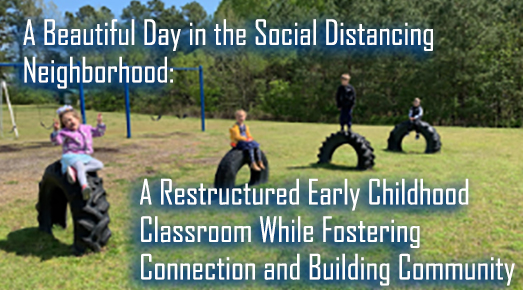
- June 19, 2020
- 2019-2020, Lower School News, Student Life
- coronavirus, COVID-19, daycare, distancing, preschool, social
The following is a piece written by our Lower School Principal, Michelle Flanagan, telling the story of how WCA was able to preview and test practices on how to effectively social distance in school by putting the guidelines into practice in our state-authorized preschool daycare, while creating community and fostering connection at the same time. The lessons learned, per her personal experience, will prove invaluable in executing on our planned reopening for our lower school in Fall 2020.
The pandemic closed all school doors Friday, March 13th; the hallways echoed and each classroom seemed beyond empty. We never felt farther away from each other, and the uncertainty was 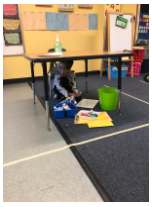 palpable. We heard the call to maintain childcare for essential personnel and reopened our doors two weeks later. Functioning safely without revealing our fears and confusion to students brought a steep learning curve. The ever-changing guidelines and protocols kept us hypervigilant. We focused on creating a warm, safe, structured, and nurturing learning environment in the midst of our new normal. For years I’ve told young parents as they leave their children for the first time, “Act the way you want your child to feel.”
palpable. We heard the call to maintain childcare for essential personnel and reopened our doors two weeks later. Functioning safely without revealing our fears and confusion to students brought a steep learning curve. The ever-changing guidelines and protocols kept us hypervigilant. We focused on creating a warm, safe, structured, and nurturing learning environment in the midst of our new normal. For years I’ve told young parents as they leave their children for the first time, “Act the way you want your child to feel.”
At first, the obstacles seemed daunting and solutions far from what we believe as best practice in the 21st-century classroom. We had to move from team tables and supplies to individual spaces and supplies. Students being agents in their learning became much more difficult as we felt the need to control their every move. Three and four-year-olds understand concrete concepts and routines. Our job now was to make these new abstract requirements as concrete as possible without revealing our uncertainty, fear, and discouragement.
I remember the day clearly as I wrote a prayer in my journal. I asked God to expand our minds; I prayed for the spirit of ingenuity and creativity. Instead of seeing limits, I wanted to see new ways and paths to ensure our children that everything would be okay and that we are safe in God’s hands. What overflowed through the staff became a beautiful neighborhood learning environment.
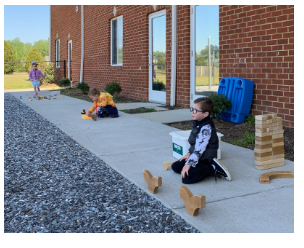 We moved 4 ft by 4ft square tables into the classroom so that our preschool children could feel free to build, create, write, think, and move. We realized quickly we could only successfully have six students to one teacher in the learning environment during the early part of the pandemic. As a standard, we have always maintained an 8-1 student-teacher ratio which is below the state student-teacher ratio. Within those new limits, we created a new classroom neighborhood. Each child had a house and a yard. Each child had neighbors to consider as they traveled throughout their neighborhood. We learned the importance of staying on the street and not cutting through someone’s yard. We practiced good citizen habits as a game and using humor rather than shame when redos were needed. We became airplanes and helicopters as we played outdoors ensuring social distancing on the playground. We were also cognizant of the amount of time our young children could maintain social distance. After a few days, our students settled into their new normal and the houses were decorated by each reflecting their individual personalities. We moved quickly from surviving towards thriving and smiles and laughter were the evidence.
We moved 4 ft by 4ft square tables into the classroom so that our preschool children could feel free to build, create, write, think, and move. We realized quickly we could only successfully have six students to one teacher in the learning environment during the early part of the pandemic. As a standard, we have always maintained an 8-1 student-teacher ratio which is below the state student-teacher ratio. Within those new limits, we created a new classroom neighborhood. Each child had a house and a yard. Each child had neighbors to consider as they traveled throughout their neighborhood. We learned the importance of staying on the street and not cutting through someone’s yard. We practiced good citizen habits as a game and using humor rather than shame when redos were needed. We became airplanes and helicopters as we played outdoors ensuring social distancing on the playground. We were also cognizant of the amount of time our young children could maintain social distance. After a few days, our students settled into their new normal and the houses were decorated by each reflecting their individual personalities. We moved quickly from surviving towards thriving and smiles and laughter were the evidence.
In the classroom neighborhood, each child learned to be more independent than we ever entrusted them to be. They opened snack bags with tenacity, 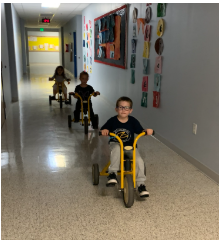 maintained the house, and organized their supplies and garbage like champs. They navigated through the unknowns of parent stress, deployments, having their temperature taken, and an abundance of hand sanitizer every step of their day. The biggest obstacle was comparison as we often want what someone else has. This is a normal struggle developmentally, but it took longer to have a turn, and children’s patience was tested. The grass is greener on the other side mentality was heightened in this season as students could not play together but return to parallel play. It’s honestly not as fun and frustrations were heard and understood. We said quite often, “ I know this is hard.” We added additional activities and toys to our resource bins to increase engagement. Additional structure and nurture were vital in helping young children understand on a deeper level what it means to be one person in the midst of a community.
maintained the house, and organized their supplies and garbage like champs. They navigated through the unknowns of parent stress, deployments, having their temperature taken, and an abundance of hand sanitizer every step of their day. The biggest obstacle was comparison as we often want what someone else has. This is a normal struggle developmentally, but it took longer to have a turn, and children’s patience was tested. The grass is greener on the other side mentality was heightened in this season as students could not play together but return to parallel play. It’s honestly not as fun and frustrations were heard and understood. We said quite often, “ I know this is hard.” We added additional activities and toys to our resource bins to increase engagement. Additional structure and nurture were vital in helping young children understand on a deeper level what it means to be one person in the midst of a community.
Daily we made connections by engaging in individual conversations, diving deeper into each child’s interests and bent, and intentionally celebrating them. Our students more than ever needed to know that we see them, know them, and love them. Hugs were replaced by extra-long air hugs or telling a child, “When I’m hugging myself I’m actually hugging you.” Air high fives, happy dances, and blowing kisses meant so much more.
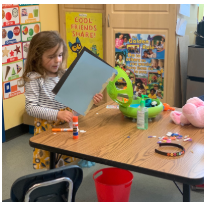 This opportunity to serve and support essential personnel through childcare ushered in a gateway for what the fall school year will look for us. We are currently creating developmentally appropriate classrooms throughout the elementary school that are greatly influenced by the preschool neighborhood concept. We have a healthy level of confidence now knowing that social distancing is the most challenging for our youngest students and if we can operate as successfully as we have with our three-year and four-year-old students, we will soar with our older students. Our highest priorities after safety are making connections with each child, having reasonable expectations, and providing on-going practice and role-plays. Each of these components along with the neighborhood design will set all learners up for success. Above all, our students and teachers are beyond capable because we have a God that ensures us that He alone is able to do more than we ever could ask or imagine in the uncharted territory we face. We trust Him as we embark on this endeavor. God makes all things beautiful in His time.
This opportunity to serve and support essential personnel through childcare ushered in a gateway for what the fall school year will look for us. We are currently creating developmentally appropriate classrooms throughout the elementary school that are greatly influenced by the preschool neighborhood concept. We have a healthy level of confidence now knowing that social distancing is the most challenging for our youngest students and if we can operate as successfully as we have with our three-year and four-year-old students, we will soar with our older students. Our highest priorities after safety are making connections with each child, having reasonable expectations, and providing on-going practice and role-plays. Each of these components along with the neighborhood design will set all learners up for success. Above all, our students and teachers are beyond capable because we have a God that ensures us that He alone is able to do more than we ever could ask or imagine in the uncharted territory we face. We trust Him as we embark on this endeavor. God makes all things beautiful in His time.
-Michelle Flanagan
WCA is accepting applications for all grades at this time for the 2020/2021 school year, and interested families can reach their Admissions Department to talk through options for enrollment, discounts, and scholarships, as well as offering a live virtual or social distanced tour of the school. Families interested in potentially enrolling at WCA, or who would like to get more information about the school should contact admissions at admissions@williamsburgchristian.org or visit our website and fill out our Interest form (click to be taken directly to either site). classroom
A Beautiful Day in the Social Distancing Neighborhood: A Restructured Early Childhood Classroom While Fostering Connection and Building Community

- June 19, 2020
- 2019-2020, Lower School News, Student Life
- coronavirus, COVID-19, daycare, distancing, preschool, social
The following is a piece written by our Lower School Principal, Michelle Flanagan, telling the story of how WCA was able to preview and test practices on how to effectively social distance in school by putting the guidelines into practice in our state-authorized preschool daycare, while creating community and fostering connection at the same time. The lessons learned, per her personal experience, will prove invaluable in executing on our planned reopening for our lower school in Fall 2020.
The pandemic closed all school doors Friday, March 13th; the hallways echoed and each classroom seemed beyond empty. We never felt farther away from each other, and the uncertainty was  palpable. We heard the call to maintain childcare for essential personnel and reopened our doors two weeks later. Functioning safely without revealing our fears and confusion to students brought a steep learning curve. The ever-changing guidelines and protocols kept us hypervigilant. We focused on creating a warm, safe, structured, and nurturing learning environment in the midst of our new normal. For years I’ve told young parents as they leave their children for the first time, “Act the way you want your child to feel.”
palpable. We heard the call to maintain childcare for essential personnel and reopened our doors two weeks later. Functioning safely without revealing our fears and confusion to students brought a steep learning curve. The ever-changing guidelines and protocols kept us hypervigilant. We focused on creating a warm, safe, structured, and nurturing learning environment in the midst of our new normal. For years I’ve told young parents as they leave their children for the first time, “Act the way you want your child to feel.”
At first, the obstacles seemed daunting and solutions far from what we believe as best practice in the 21st-century classroom. We had to move from team tables and supplies to individual spaces and supplies. Students being agents in their learning became much more difficult as we felt the need to control their every move. Three and four-year-olds understand concrete concepts and routines. Our job now was to make these new abstract requirements as concrete as possible without revealing our uncertainty, fear, and discouragement.
I remember the day clearly as I wrote a prayer in my journal. I asked God to expand our minds; I prayed for the spirit of ingenuity and creativity. Instead of seeing limits, I wanted to see new ways and paths to ensure our children that everything would be okay and that we are safe in God’s hands. What overflowed through the staff became a beautiful neighborhood learning environment.
 We moved 4 ft by 4ft square tables into the classroom so that our preschool children could feel free to build, create, write, think, and move. We realized quickly we could only successfully have six students to one teacher in the learning environment during the early part of the pandemic. As a standard, we have always maintained an 8-1 student-teacher ratio which is below the state student-teacher ratio. Within those new limits, we created a new classroom neighborhood. Each child had a house and a yard. Each child had neighbors to consider as they traveled throughout their neighborhood. We learned the importance of staying on the street and not cutting through someone’s yard. We practiced good citizen habits as a game and using humor rather than shame when redos were needed. We became airplanes and helicopters as we played outdoors ensuring social distancing on the playground. We were also cognizant of the amount of time our young children could maintain social distance. After a few days, our students settled into their new normal and the houses were decorated by each reflecting their individual personalities. We moved quickly from surviving towards thriving and smiles and laughter were the evidence.
We moved 4 ft by 4ft square tables into the classroom so that our preschool children could feel free to build, create, write, think, and move. We realized quickly we could only successfully have six students to one teacher in the learning environment during the early part of the pandemic. As a standard, we have always maintained an 8-1 student-teacher ratio which is below the state student-teacher ratio. Within those new limits, we created a new classroom neighborhood. Each child had a house and a yard. Each child had neighbors to consider as they traveled throughout their neighborhood. We learned the importance of staying on the street and not cutting through someone’s yard. We practiced good citizen habits as a game and using humor rather than shame when redos were needed. We became airplanes and helicopters as we played outdoors ensuring social distancing on the playground. We were also cognizant of the amount of time our young children could maintain social distance. After a few days, our students settled into their new normal and the houses were decorated by each reflecting their individual personalities. We moved quickly from surviving towards thriving and smiles and laughter were the evidence.
In the classroom neighborhood, each child learned to be more independent than we ever entrusted them to be. They opened snack bags with tenacity,  maintained the house, and organized their supplies and garbage like champs. They navigated through the unknowns of parent stress, deployments, having their temperature taken, and an abundance of hand sanitizer every step of their day. The biggest obstacle was comparison as we often want what someone else has. This is a normal struggle developmentally, but it took longer to have a turn, and children’s patience was tested. The grass is greener on the other side mentality was heightened in this season as students could not play together but return to parallel play. It’s honestly not as fun and frustrations were heard and understood. We said quite often, “ I know this is hard.” We added additional activities and toys to our resource bins to increase engagement. Additional structure and nurture were vital in helping young children understand on a deeper level what it means to be one person in the midst of a community.
maintained the house, and organized their supplies and garbage like champs. They navigated through the unknowns of parent stress, deployments, having their temperature taken, and an abundance of hand sanitizer every step of their day. The biggest obstacle was comparison as we often want what someone else has. This is a normal struggle developmentally, but it took longer to have a turn, and children’s patience was tested. The grass is greener on the other side mentality was heightened in this season as students could not play together but return to parallel play. It’s honestly not as fun and frustrations were heard and understood. We said quite often, “ I know this is hard.” We added additional activities and toys to our resource bins to increase engagement. Additional structure and nurture were vital in helping young children understand on a deeper level what it means to be one person in the midst of a community.
Daily we made connections by engaging in individual conversations, diving deeper into each child’s interests and bent, and intentionally celebrating them. Our students more than ever needed to know that we see them, know them, and love them. Hugs were replaced by extra-long air hugs or telling a child, “When I’m hugging myself I’m actually hugging you.” Air high fives, happy dances, and blowing kisses meant so much more.
 This opportunity to serve and support essential personnel through childcare ushered in a gateway for what the fall school year will look for us. We are currently creating developmentally appropriate classrooms throughout the elementary school that are greatly influenced by the preschool neighborhood concept. We have a healthy level of confidence now knowing that social distancing is the most challenging for our youngest students and if we can operate as successfully as we have with our three-year and four-year-old students, we will soar with our older students. Our highest priorities after safety are making connections with each child, having reasonable expectations, and providing on-going practice and role-plays. Each of these components along with the neighborhood design will set all learners up for success. Above all, our students and teachers are beyond capable because we have a God that ensures us that He alone is able to do more than we ever could ask or imagine in the uncharted territory we face. We trust Him as we embark on this endeavor. God makes all things beautiful in His time.
This opportunity to serve and support essential personnel through childcare ushered in a gateway for what the fall school year will look for us. We are currently creating developmentally appropriate classrooms throughout the elementary school that are greatly influenced by the preschool neighborhood concept. We have a healthy level of confidence now knowing that social distancing is the most challenging for our youngest students and if we can operate as successfully as we have with our three-year and four-year-old students, we will soar with our older students. Our highest priorities after safety are making connections with each child, having reasonable expectations, and providing on-going practice and role-plays. Each of these components along with the neighborhood design will set all learners up for success. Above all, our students and teachers are beyond capable because we have a God that ensures us that He alone is able to do more than we ever could ask or imagine in the uncharted territory we face. We trust Him as we embark on this endeavor. God makes all things beautiful in His time.
-Michelle Flanagan
WCA is accepting applications for all grades at this time for the 2020/2021 school year, and interested families can reach their Admissions Department to talk through options for enrollment, discounts, and scholarships, as well as offering a live virtual or social distanced tour of the school. Families interested in potentially enrolling at WCA, or who would like to get more information about the school should contact admissions at admissions@williamsburgchristian.org or visit our website and fill out our Interest form (click to be taken directly to either site). classroom
More News:

